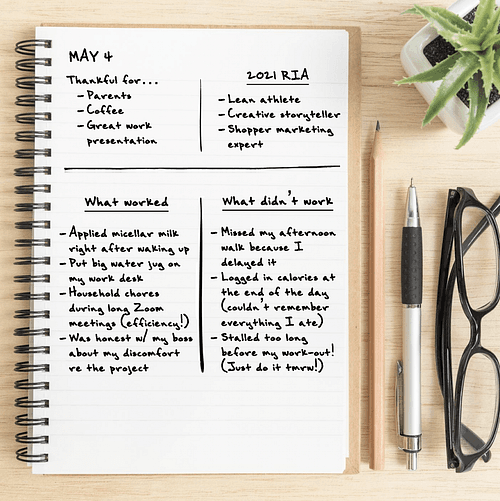This Is the Journaling Template for People Who Don’t Have Time to Journal
Curated from: forge.medium.com
Ideas, facts & insights covering these topics:
8 ideas
·56 reads
Explore the World's Best Ideas
Join today and uncover 100+ curated journeys from 50+ topics. Unlock access to our mobile app with extensive features.
How often people do Journaling?
It is easy for people to journal religiously — until they have a lot on their plate. When their days are quickly filled up with work, chores, exercise, and writing. With less time and energy, it becomes difficult for them to take the time to sit and reflect. Days, sometimes even weeks, would pass between entries.
3
25 reads
The Four Corner Journaling.
Some people have trouble fitting the task into thier daily schedule. Or maybe they want to journal but don’t know where the start. (Anyone else overwhelmed by the multitude of writing prompts out there? What are you grateful for? Did you learn something new about yourself? What does your future self look like?) Recently, Ria Tagulinao came up with a method to make the habit more manageable. It’s called Four Corner Journaling.
3
4 reads
How to do?
The one-page template consists of — you guessed it — four corners: gratitude, goal commitment, and a daily review (what went well and what didn’t). Here’s what it looks like for me:
4
6 reads
Gratitude corner
The upper left corner is where you apply The Three Good Things — a count-your-blessing practice that can improve psychological wellbeing. Simply start with “I’m thankful for…” and then list at least three things you’re grateful for that day.
3
5 reads
“Future you” corner
The upper right corner is where you remind yourself of who you want to become or what you want to achieve. Research shows that the more you clarify and feel connected with your future self, the more you’re “willing to make choices today that may benefit [you] at some point in the years to come.” In this section, write “2021 [your name].” Then write down what you hope to become by the end of the year.
3
3 reads
The Principle
The most brilliant advice on how to manage yourself "Pause for five minutes at the end of every day and just think about what happened that day.” Every initiative could be evaluated using two columns: What worked and what didn’t work?
This framework has proved to be working intuitive and straightforward. Best of all, it required us to focus only on the things that were within our control.
Apply this framework to journaling and you’ll be forced to think about your behavior — what was it that you did that day that worked or didn’t?
3
4 reads
A Example of such situations.
For example, maybe you folded your laundry while listening in on a Zoom seminar. This kept you from scrolling through Twitter, so you successfully paid attention to the meeting and ticked off a household chore. That worked. But maybe you also intended to hit 2,000 steps after lunch. Instead, you delayed it to after your work day. Your last meeting took longer than expected, leaving you with no time to go for a walk. That did not work.
3
6 reads
What it's all about.
Journaling doesn’t need to be fancy, complicated, or long-winded. What’s important is that it does the job and is done regularly. Find what works for you and feel yourself becoming closer to the person you want to become, one page at a time.
3
3 reads
IDEAS CURATED BY
Md.AbdulRahman Hassan's ideas are part of this journey:
Learn more about habits with this collection
How to choose the right music for different tasks
The benefits of listening to music while working
How music affects productivity
Related collections
Similar ideas
3 ideas
What's All This About Journaling?
nytimes.com
13 ideas
How to Build a Daily Personal Journaling Habit
developgoodhabits.com
Read & Learn
20x Faster
without
deepstash
with
deepstash
with
deepstash
Personalized microlearning
—
100+ Learning Journeys
—
Access to 200,000+ ideas
—
Access to the mobile app
—
Unlimited idea saving
—
—
Unlimited history
—
—
Unlimited listening to ideas
—
—
Downloading & offline access
—
—
Supercharge your mind with one idea per day
Enter your email and spend 1 minute every day to learn something new.
I agree to receive email updates

